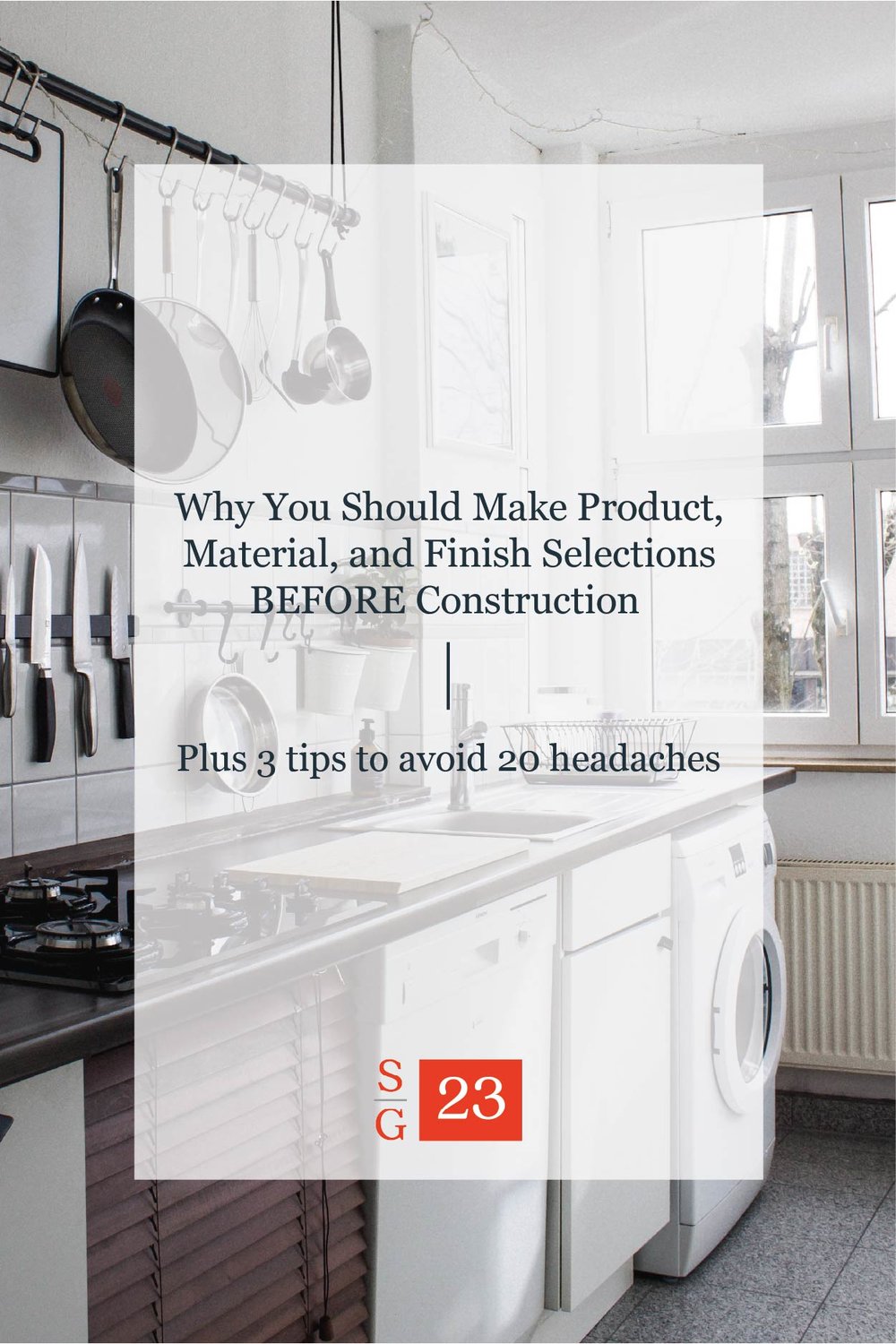Why You Should Make Product, Material, and Finish Selections BEFORE Starting Construction
When I’m on Facebook, I often see posts on neighborhood pages that are asking for contractor recommendations. I immediately think, did they make any of their selections yet? If it’s a bathroom renovation, did they pick out the vanity, tile, light fixtures, or plumbing fixtures? If not, the project already isn’t running as smoothly as they think. But there’s a solution.
When working with clients, I have a solid design concept and all selections made before we even ask for estimates. It makes the project run much more smoothly. I understand that between work, kids, vacations, and just the day-to-day tasks, selecting all of these items right away isn’t necessarily a priority. However, making all the decisions ahead of time will benefit your project (and your sanity) in the long run.
Surprises for the Contractor = More Fees
Your selections influence what the contractor is going to propose in their estimate. We all want the most accurate estimate we can get so that there aren’t any surprises later. For example, I had a client that wanted a wall-mounted faucet. It has a modern aesthetic, frees up a bit of counter space, and is ideal for a vessel sink. However, what most homeowners don’t know is that the install for a wall-mounted faucet is more complex than a standard deck-mounted faucet. More labor = more fee. In addition, the valve in the wall that actually makes the faucet work usually costs significantly more.
Now, most people who want that wall-mounted faucet go for it because it looks awesome. Since we already have that faucet selected, we can provide that information to the contractor to include in their estimate instead of letting them assume that it’s a standard deck-mounted faucet. Informing them of the appropriate faucet beforehand gives you an idea of the expected cost rather than the contractor adding a fee later on. They’ll also make sure that they run the plumbing appropriately in the wall, instead of having to reopen the wall after they find out they need to extend the plumbing up the wall. Again, more labor = more fee.
Delayed Selections Can Delay the Project
This is how most renovation projects play out. A homeowner hires a contractor after reviewing an estimate that hasn’t taken every detail into account, because frankly the contractor wasn’t provided with enough information. Then, during construction, there’s a day where the contractor will call and ask which light fixture the homeowner wants in the dining room. Due to the time restriction, a generic selection may be made, but if a client wants something more unique or of higher quality, it’s probably going to need to be ordered. Lead time could be something like 4 weeks for that dream light fixture in your new dining room. This would delay the electrician, ceiling paint, etc. Further, the electrician and painters may be on another project in 4 weeks. Do you see how making one selection late in the process can cause a snowball effect?
At SG23 Design, our goal is to have everything the contractor will need onsite well before he/she needs it. In fact, for smaller projects we have all items onsite before the contractor even gets started.
Below are my tips to avoid surprise delays and additional fees:
1. Make as Many Selections as Possible Before Consulting with a Contractor
The more information a contractor has from the beginning, the more accurate of a quote they can provide. You may not know where to get a specific freestanding tub that you saw in a design magazine, but the contractor should at least know that’s what you want. And an interior designer had the resources to find that exact tub or something comparable.
2. Pay Attention to Lead Times
When making selections, pay attention to lead times. A lead time is the time it takes for the item to be made, prepared, packaged, and shipped. Lead times can range from days to months. I always assume a 4-6 week lead time, but I double check with the manufacturer.
It’s also worth noting that just because it’s in stock, doesn’t mean you’re getting it in a few days. It you’re on the east coast and the item is coming from Texas you’re not getting that item in 2 days. Also, freight for larger items like a sofa or an oversized rug typically takes longer than product shipping in a box.
3. Inspect Deliveries
Just because a box isn’t damaged, doesn’t mean what’s inside isn’t. Account for any time to receive a replacement.
Picking out all your flooring, wall tile, lighting, built-in furniture, and fixtures has the potential to be overwhelming. If you need help making any selections for a project, we’re here to help! Book a free information session.


